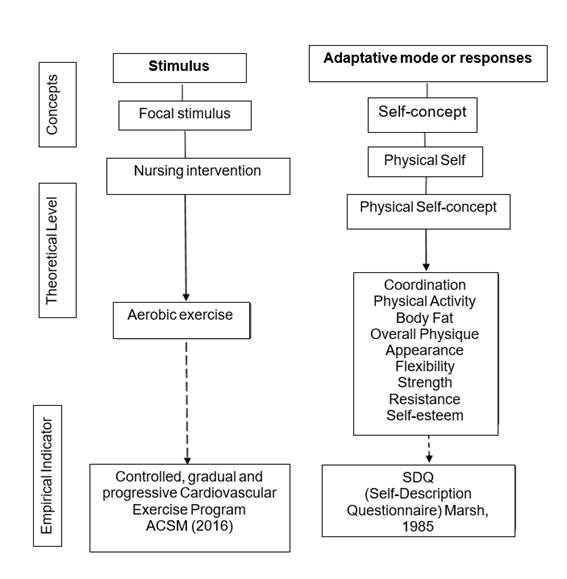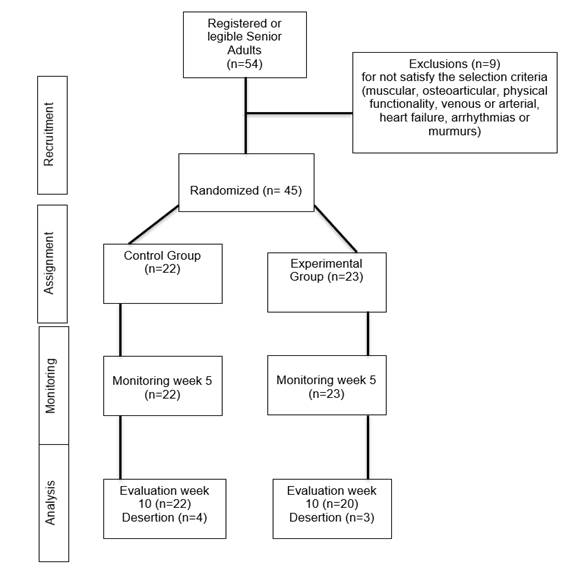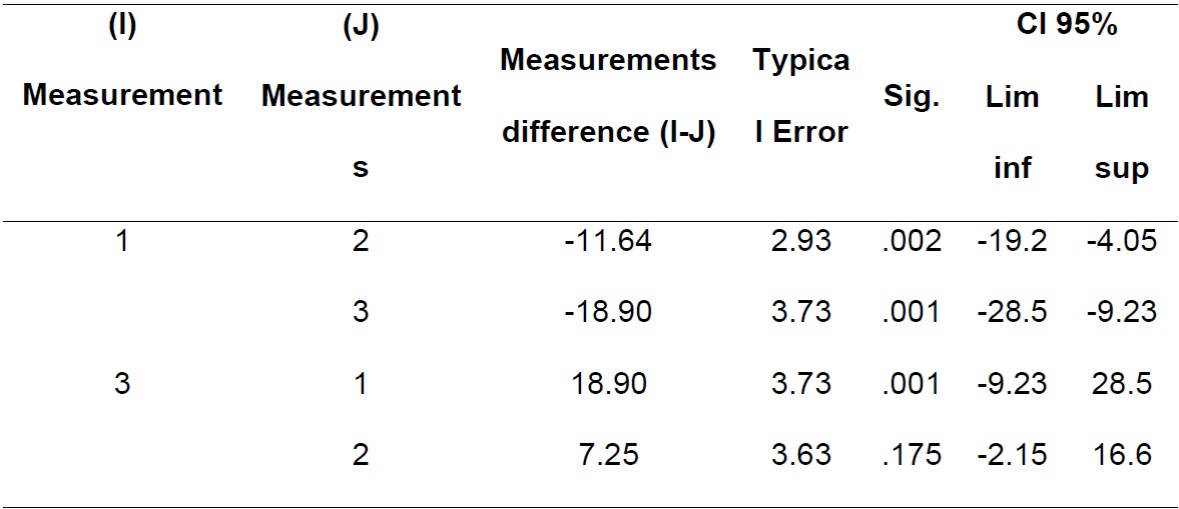Mi SciELO
Servicios Personalizados
Revista
Articulo
Indicadores
-
 Citado por SciELO
Citado por SciELO -
 Accesos
Accesos
Links relacionados
-
 Citado por Google
Citado por Google -
 Similares en
SciELO
Similares en
SciELO -
 Similares en Google
Similares en Google
Compartir
Enfermería Global
versión On-line ISSN 1695-6141
Enferm. glob. vol.19 no.60 Murcia oct. 2020 Epub 21-Dic-2020
https://dx.doi.org/10.6018/eglobal.403851
Originals
Cardiovascular exercise effect in self-concept in seniors: clinical trial
1Ph in Nursing Sciences. Benemérita Universidad Autónoma de Puebla, Puebla. México. erick_landeross@hotmail.com
2Master in Nursing. Hospital de la Sociedad Española de Beneficencia de Puebla, Puebla. México.
3Master in Nursing. Hospital Ángeles de Puebla, Puebla. México.
4Master in Nursing. Benemérita Universidad Autónoma de Puebla, Puebla. México.
5Ph in Nursing Sciences. Universidad Autónoma de Nuevo León, Monterrey. México.
Objective:
To describe the effect of a dose of gradual and progressive exercise of low cardiovascular impact on physical self- concept in a group of seniors.
Methods:
Randomized, controlled clinical trial with a blinded experiment in two equivalent groups (experimental one and control one), under a repeated model of measures The sample consisted of 20 individuals per group. Male and female seniors from 60 to 70 years old with no heart risk, were selected. Seniors with pathologies that could cause limitations on the musculoskeletal function cardiopulmonary functionality were excluded. The intervention consisted of performing exercise gradually and progressively, 3 times a week for 10 weeks. The indicator for assessing physical self-concept was the Self-Description Questionnaire (SDQ), with a Likert response pattern.
Results:
45 individuals were taken; control group 22 adults (age 66.6 ± 6.14) and experimental group 23 adults (age 67.0 ± 7.19); 38 adults completed the progrAm In both groups, women predominated (66.7%), medium socioeconomic level (73.3%) and basic schooling (44.6%). There was no significant difference between the groups before the intervention, in contrast, after the intervention there was a significant difference between them, which resulted in an increase in physical self-concept in the experimental group and a decrease in physical self-concept in the control group.
Conclusion:
The intervention of controlled, gradual, progressive and low cardiovascular impact exercise of three sessions per week for 10 weeks proved to be effective in increasing physical self-concept in the experimental group of adults.
Keywords: Clinical trial; Exercise; Self-concept; Senior Adult; Nursing Theory
INTRODUCTION
Population aging is a demographic problem that represents a challenge for governments and institutions to adopt conducive measures and address the effects of the phenomenon. According to the World Health Organization 1, the percentage of senior adults (SA) in the world will double exponentially, from 12% in 2015 to 22% in 2050. In Latin America, 11% of the current population is over 60 years old and SA is expected to represent 17% of the general population by 2030 2. Mexico also presents a dizzying aging process; the SA went from 6.2% in 2010 to 7.2% in 2015 and it is expected that by 2050 this population will increase to 16.2% 3.
The aging process brings important health consequences; On the one hand, physical inactivity has been predominantly documented, since 14.4% of SA do not exercise regularly 4, which favors the development of chronic noncommunicable diseases (NCDs) (diabetes, cancer, brain, and cardiovascular events). On the other hand, high percentages of emotional disturbances such as symptoms of anxiety, depression, low self-esteem, and decreased physical self-concept are reported 5. Additionally, the Mexican health system does not have physical activity and/or exercise programs to avoid these consequences 6.
Despite the absence of specific exercise programs for SA, multiple benefits have been documented in this population since they improve cardiac functioning, blood pressure 7,8, functional strength 9, favor autonomy 6,10,11, and improve physical self-concept12.
This is where the use of theoretical frameworks to support health interventions becomes important, as indicated by the Callista Roy Adaptation Model 13, which describes human beings as adaptive systems that generate behaviors (physical exercise) from inputs (focal, contextual and residual stimuli); The actions and reactions resulting from these stimuli are classified into four adaptive response modes: 1) physiological, related to neural, chemical and endocrine processes to cover basic needs; 2) role, which represents the function within society; 3) interdependence, based on interaction with others and 4) psychological, which refers to self-concept, defined as the set of beliefs and feelings that the person has about oneself; It is composed of sub-areas that give direction to the behavior about the physical self (ability to physically feel external stimuli) and the personal self (self-ideal, self-consistency, and spiritual-ethical-moral self).
The general self-concept has specific components for specific situations; for this study, physical self-concept (PSC) will be considered, since it plays an important role in interpersonal relationships, in social interaction, psychic functioning and the health of SA. According to Marsh and Shavelson 14, the PSC is divided into two dimensions; physical ability and physical appearance, with nine domains: coordination, physical activity, body fat, global physique, appearance, strength, flexibility, resistance and self-esteem. The PSC has been positively related to indicators of well-being in SA such as physical functionality, positive affect and emotional adjustment 12. However, the quality of this evidence is limited by the design of the studies, which do not yield conclusive results from the experimental point of view, since a specific exercise dose has not been established to assess the statistical effect of the exercise on PSC in all its domains in the population of SA; Theoretically, the nursing professional is the right health personnel with the necessary tools to establish a program of gradual and controlled exercise in the SA that can contribute to improving the PSC; this improvement can have an impact on the decrease of chronic degenerative diseases, an increase in the quality of life in the SA and a positive economic impact on families, communities and the health system.
Therefore, it was proposed to describe the effect of a gradual progressive exercise dose of low cardiovascular impact on physical self-concept in a group of senior adults.
MATERIAL AND METHOD
Randomized and Controlled Clinical Trial (RCCT), with a blinded experiment in two equivalent groups (experimental and control), under a repeated measurement model. Senior Adults (SA) from 60 to 70 years old, of both genders, without cardiac risk and who approved the functional assessments 15,16 were selected. SA with pathologies that could cause limitations in musculoskeletal or cardiopulmonary functionality were excluded. The sampling was probabilistic by block technique, the sample size was calculated using a statistical program with a test power of .80, effect size .30 and significance level of .05, the sample size resulted in 16 subjects per group. To cushion the effect of attrition, the n per group was 20 individuals.
In this research, a theoretical derivation 17 was realized to explain its intervention and results based on Roy's Adaptation Model 13 and the theoretical approach on PSC by Marsh and Shavelson 14. The focal stimulus was considered as the dose of exercise applied to the SA to generate modifications in the PSC and its domains, which is part of the adaptive psychological response mode (Figure 1).
Hypothesis. Based on one of Roy's postulates 13, which mentions: "When a response mode changes before a focal stimulus (such as exercise) the other modes or responses are also modified", the following hypothesis was formulated: If SA are considered as an adaptive system to the environment that generates physical and psychological responses to the stimuli, then subjecting a group of SA to a focal stimulus of controlled, gradual, progressive and low-impact physical activity of three sessions per week during 10 weeks they will show a positive adaptation response about physical self-concept.
The indicator used to evaluate the PSC was the SDQ Self-Description Questionnaire14, which assesses the appearance and physical ability in 55 test items, distributed in the domains: coordination (items 1, 10, 19, 28, 37,46 ); physical activity (items 2, 11, 20, 29, 38, 47); body fat (items 3, 12, 21, 30, 39, 48); global physical (items 4, 13, 22, 31, 40, 49); appearance (items 5, 14, 23, 32, 41, 50); strength (items 6, 15, 24, 33, 42, 51); flexibility (items 7, 16, 25, 34, 43, 52); resistance (items 8, 17, 26, 35, 44, 53) and self-esteem (items 9, 18, 27, 36, 45, 54, 55). The response pattern corresponds to a Likert scale that ranges from 1 = never, 2 = rarely, 3 = occasionally, 4 = often and 5 = always; being the maximum value 275 points and the minimum 55 points, the higher the score, the greater the physical self-concept perceived. The instrument has been validated in different populations, obtaining Cronbach's alpha coefficients between .81 to .94 18. Cronbach's alpha for the present research was .88.
In relation to the procedure, for recruitment brochures and leaflets were distributed and sings were placed in the areas of greatest affluence of the SA, in which the dates and hours of attention were indicated to perform the functionality tests and the cardiovascular assessments that included the records of the percentage of body fat and electrocardiogram, under the supervision of a certified doctor. Also, the application of the SDQ instrument was made. Functionality tests and cardiac examination were performed in a quiet and comforTable space in the clinical laboratory area of a Faculty of Health.
The exercise program consisted of three parts: in the first, the vital signs were registered, participants were hydrated according to the weight in kilograms and started the warm-up exercises in the cephalocaudal direction. In the second part: SA exercised gradually and progressively, started with 10 minutes and concluded with 30 minutes of exercise on a treadmill, with a frequency of three times per week for ten weeks. The effort was gradually calculated from 20% to 50% of the Heart Rate Reserve (HRR) 19 and controlled with the speed and treadmill incline. Additionally, the SA identified the perception of physical effort with the Borg Scale 20, as a clinical reference to the control of vital signs and cardiac auscultation while on the treadmill. In the third part, stretching and breathing exercises were performed to ensure that the vital signs were re-established to normal parameters, again they were hydrated to conclude the session. The details of the exercise dosage are shown in Table 1.
Table 1. Dosage of aerobic exercise in SA
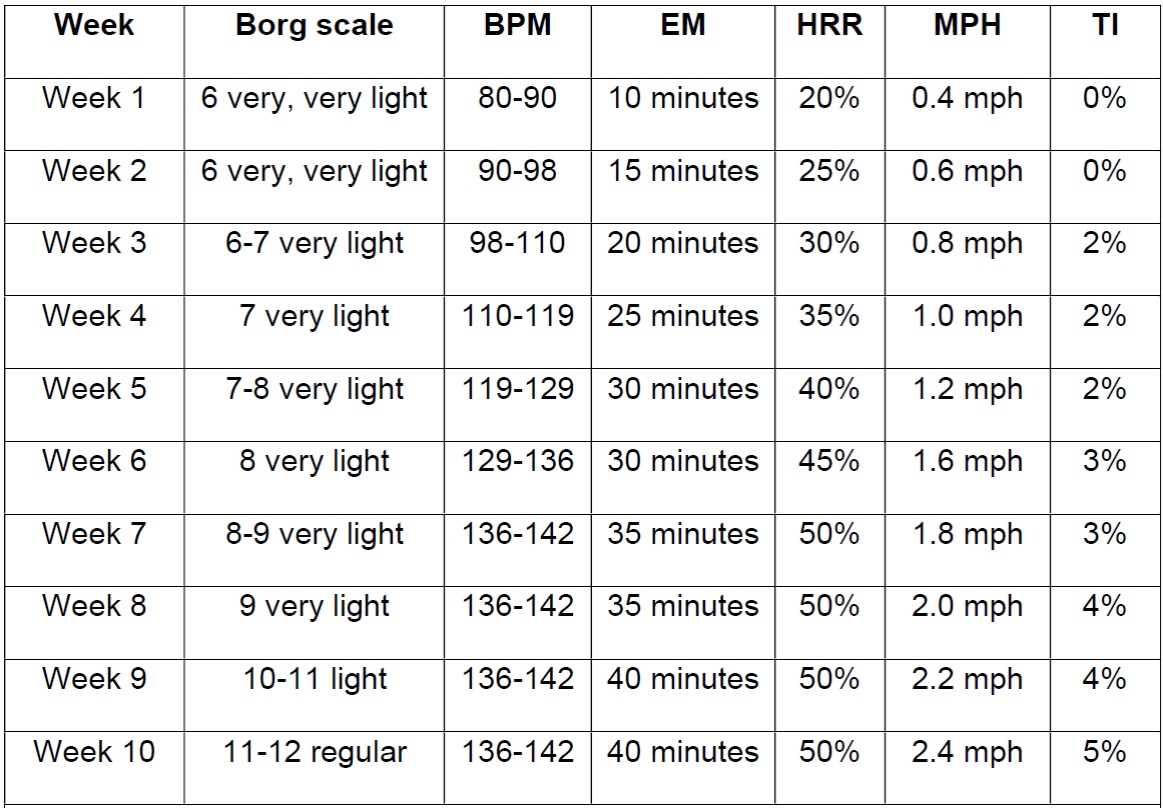
Note. BPM. Beats per minute, EM. Exercise minutes, MPH. Miles per Hour,
TI. Treadmill Incline. Source: Own making
For the statistical analysis, the normal distribution curve of the dependent variable was determined with the Kolmogorov-Smirnov normality test (p> .05), therefore a repeated measures variance analysis (ANOVA RM) was used and the Comparisons between groups with Student t (Figure 2). Three PSC measurements were made, at week 0, week 5 and week 10 of the intervention.
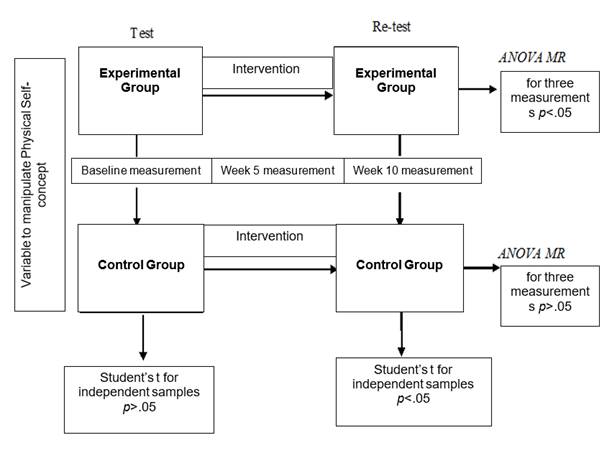
Note. Measurement scheme. Source. Own making
Figure 2: Schematic representation of the statistical analysis plAn
This research was carried out in accordance with the provisions of the General Health Law on research 21. Written informed consent was provided, the purpose of the study, the description of procedures, benefits and risks were communicated; keeping confidentiality, privacy and anonymity. This work was endorsed by the Research and Postgraduate Studies Committee of an educational institution of the State of Puebla, with the registration number SIEP / ME / 056/2016.
RESULTS
45 individuals were admitted, for the control group 22 SA (age 66.6 ± 6.14) and for the experimental group 23 SA (age 67.0 ± 7.19); 38 SA completed the progrAm The progression of the design is shown in Figure 3.
The sociodemographic characteristics were equivalent for the two groups; in both women predominated (66.7%), the middle socioeconomic level (73.3%) and basic education (primary and secondary) (44.6%); none of the participants did regular exercise when selected, high blood pressure (31%) and diabetes mellitus 2 were the predominant chronic diseases(26%). 37.7% of SA mentioned being single.
To perform the contrast of both groups in the test and in the re-test, two Student t-statistics were done for unrelated samples, a priori fulfilling the assumptions of normality (KS = .12, p = .200) and homoscedasticity of the variance through the Levene test (p> .05). The findings indicated that in the test, there is no statistically significant difference between the groups before the intervention in the general PSC.
In contrast, after the exercise intervention for ten weeks, there is a difference in the means and standard deviations in the re-test of both groups of SA.
There is an increase in the general PSC in the EG and a decrease in the PSC in the CG. The data is presented in Table 2.
Table 2. Student's t-test for the contrast of averages of unrelated groups
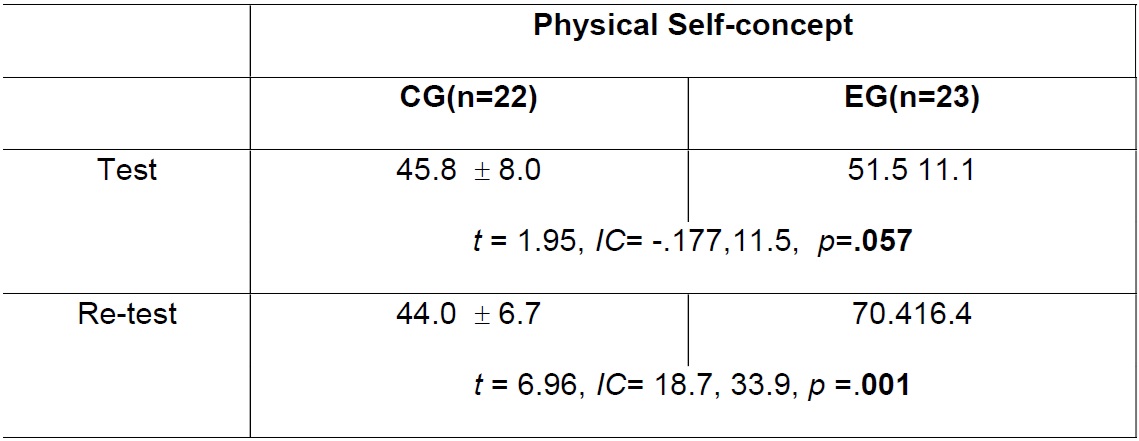
Source: Own making
Note: Arithmetic averages are presented with standard deviation CG= Control Group, EG=Experimental Group. CI= Confidence Interval to 95%, df=degrees of freedom (43).
When performing the statistical contrast of the dimensions of the PSC in the test, no significant differences were observed; however, when examining the averages obtained at the end of the EG intervention, a change in the physical appearance domain was observed with the significant increase in the global physique dimension, appearance, and self-esteem. In the domain of physical ability, all dimensions (coordination, physical activity, strength, flexibility, and resistance) showed a significant increase in arithmetic averages (Table 3).
Table 3. Student's t-test of CG and EG retest, according to PSC domain and dimension
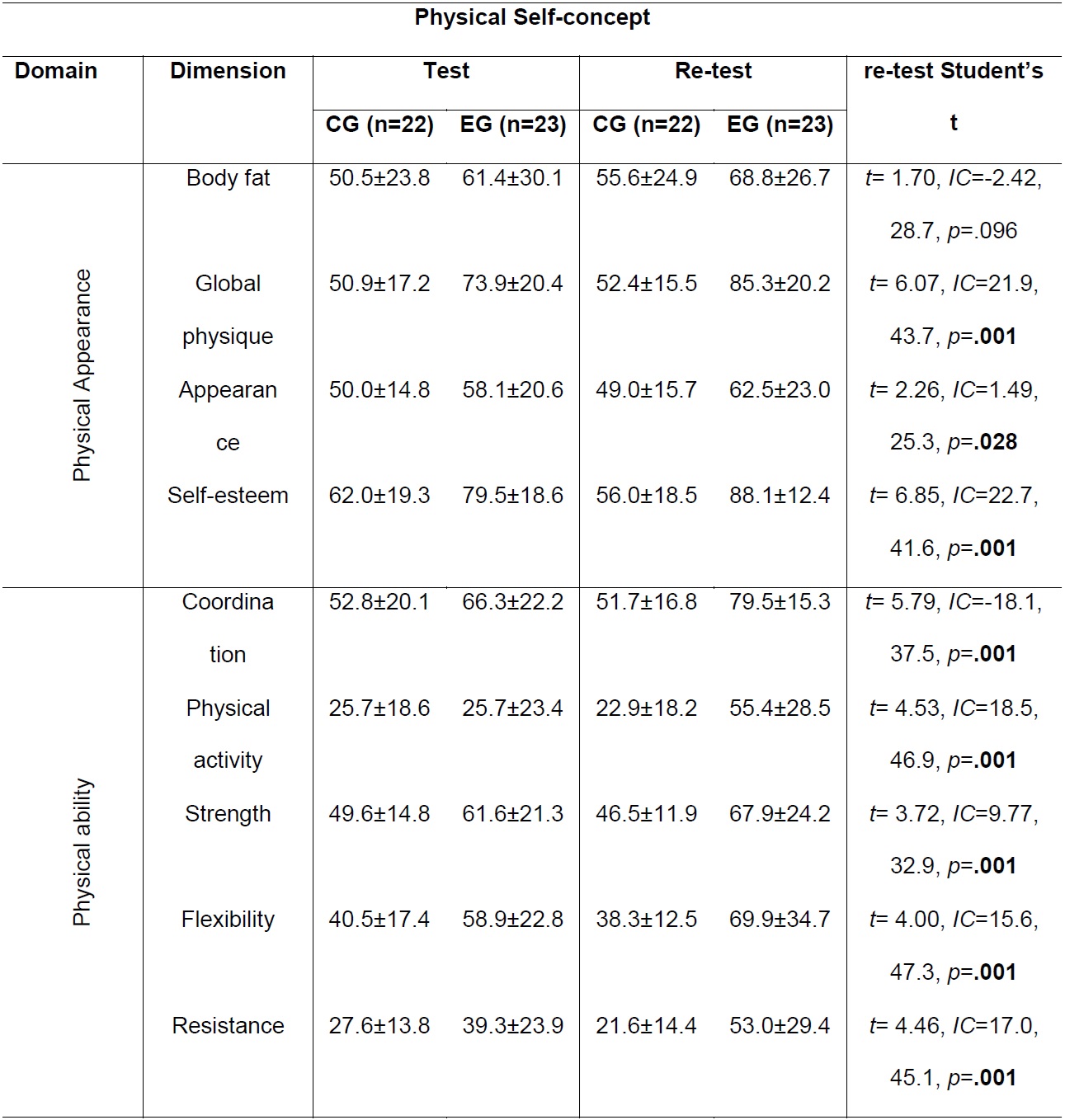
Source: Own making
Note: Arithmetic averages are presented with standard deviation CG= Control Group, EG=Experimental Group. CI= Confidence Interval to 95%, df=degrees of freedom (43).
Table 4 shows the values of the multiple comparisons between the three measurements of the EG (Post Hoc / Tukey Test). Significant changes were observed from measurement one compared to measurements two and three (p <.05). However, the values of the second measurement compared to the third do not present a significant difference. In the CG no statistical significance is observed (data not shown).
DISCUSSION
The objective of the study was to describe the effect of a gradual progressive exercise dose of low cardiovascular impact on physical self-concept in a group of senior adults. The exercise intervention was based on Roy's Adaptation Model 13 and was based on Marsh's concepts of physical self-concept 14. Two groups of SA were examined whose personal characteristics were equivalent in age, marital status and socio-economic level, most of the participants in both groups were women between 60 and 70 years of age, a large part of the sample presented arterial hypertension. The main effect of the exercise dose was a general increase in PSC during the 10-week exercise program in the EG.
In relation to the theoretical postulates of Roy 13, controlled cardiovascular exercise as a focal stimulus and as a permanent habit, was shown to improve and increase the PSC, as reported by Bohórquez et al. 6, who did not find significant differences between men and women. Additionally, other authors have reported the importance of this cognitive variable as a predictor and determinant for the maintenance of physical and mental health in the SA to achieve a better quality of life 22,23.
In relation to the psychological response mode determined by the PSC in SA, the increase in domains of physical appearance and physical ability was determined. In the first, the dimensions that had a statistically significant increase were the global physique, appearance and self-esteem; The improvement in these dimensions is consistent with the published literature 22, since the performance of physical activity in SA has anti-inflammatory, antioxidant effects, improves vascularization facilitating a better color and quality of the skin and hair, lessens retention of fluids, improves the immune system, decreases insulin secretion, improves intestinal rhythm and in general the AM have a greater functional health, which greatly favors the appearance and positively affects the increase of self-esteem.
Regarding the second domain, all dimensions (coordination, physical activity, strength, flexibility, resistance) showed significant improvement in consistency with the literature, since physical exercise improves the functioning of the nervous system, which represents a lower risk of falls, functions better conserved cognitive and lower risk of moderate and severe functional limitations; which allows the SA to improve the performance of the basic and instrumental activities of daily life 8,9,10.
The change in both PSC domains was presented starting with week number five, as Cardona et al. 10 after a 150-minute intervention, three times a week for 10 weeks, based on respiratory and aerobic exercise. Specifically, López 24 reported an increase in muscle strength after performing a 30-minute exercise program for 8 weeks. In contrast, other authors such as Calero et al. 22 took six months to obtain significant results. The findings of the clinical trial show that to test the effect of exercise on PSC in SA, it is not necessary 10 weeks of exercise, only half is required.
The study presented some conditions that could limit the obtained results, such as: not having a greater number of facilitators to generate evening sessions and test if there is a difference between schedules (adherence) to exercise, given that the literature reflects that the morning schedule is much better for the adherence of SA in relation to the dose of exercise; the additional measurement of variables such as glucose, blood pressure and weight was not carried out to be able to test whether other physical variables can also improve with this exercise dose and to analyze other cognitive variables; No strength exercises and repetitions were performed to prevent SA from having heart problems.
CONCLUSION
The intervention of controlled, gradual, progressive and low cardiovascular impact physical activity, of three sessions per week for 10 weeks, proved effectiveness in increasing the PSC and its domains in the experimental group of senior adults. This result proves the hypothesis of this study through the postulate of the Roy adaptation model 13, which establishes that the SA is an adaptive system to the environment that generates physical and psychological responses to different stimuli.
REFERENCIAS
1. Organización Mundial de la Salud. Envejecimiento y salud, Notas descriptivas 2018. Disponible en: http://www.who.int/es/news-room/fact-sheets/detail/envejecimiento-y-salud [ Links ]
2. Federación Iberoamericana de Asociaciones de Personas Adultas Mayores FIAPAm America Latina envejece a pasos de gigantes. 2019. Disponible en: https://fiapAmorg/america-latina-envejece-a-pasos-de-gigante/ [ Links ]
3. Instituto Nacional de Estadística, Geografía e Informática. Proyecciones de la población de México 2010-2050. Recuperado de: http://www3.inegi.org.mx/sistemas/sisept/Default.aspx?t=mdemo249&s=est&c=339 [ Links ]
4. Instituto Nacional de Salud Pública. Encuesta Nacional de Salud y Nutrición de Medio Camin. Informe Final de Resultados. Secretaria de Salud de México, 2016. [ Links ]
5. Santana YDLCB., Enríquez JB, Rodríguez YM, Díaz AS. Determinación de los factores psicosociales potenciadores de conductas suicidas en los adultos mayores MediCiego [Internet]. 2015 [citado 15 septiembre 2019]; 21(1). Disponible en: http://www.revmediciego.sld.cu/index.php/mediciego/article/view/85 [ Links ]
6. Bohórquez MR, Lorenzo M, García AJ Actividad física como promotor del autoconcepto y la independencia personal en personas mayores Revista Iberoamericana de Psicología del Ejercicio y el Deporte [Internet]. 2014 [citado 15 septiembre 2019]; 9(2), 533-546. Disponible en: https://idus.us.es/xmlui/handle/11441/59364 [ Links ]
7. Hernández O, Ramírez F. Programa de ejercicio estructurado es viable y mejora la capacidad funcional en adultos mayores en Puerto Rico. Rev Ciencias del Ejercicio y Salud [Internet]. 2014 [citado 20 septiembre 2019]; 12(2). 1-15. Disponible en: http://repositorio.ucr.ac.cr/handle/10669/21645 [ Links ]
8. Wehmeyer C, Loots JM, Nortjé, L, Lategan, L. The effects of supervised exercise training and self -directed active daily living on fitness and health parameters in elderly males with type II diabetes. African journal for physical, Health education, recreation and dance [Internet]. 2014 [citado 20 septiembre 2019]; 20(4:1). 1424-1435 [ Links ]
9. Rodríguez-Berzal E, Aguado-Jódar X. Efectos del entrenamiento de la fuerza funcional en persons mayores Apunts [Internet]. 2015 [citado 20 septiembre 2019]; 10(09). 64-71. Disponible en: https://www.sciencedirect.com/science/article/abs/pii/S1886658115000304 [ Links ]
10. Garcia NC, Ramirez JCG, Ypia MAT, Tonguino-Rosero S. Efecto de un programa de ejercicios respiratorios y aeróbicos en medio acuático versus terrestre para adultos mayores Revista salud UIS [Internet]. 2016 [citado 20 septiembre 2019]; 48(4). Disponible en: https://revistas.uis.edu.co/index.php/revistasaluduis/article/view/5835 [ Links ]
11. García FG, Angulo J. Análisis de rasgos de personalidad positiva y bienestar psicológico en personas mayores practicantes de ejercicio físico vs no practicantes. Revista Iberoamericana de Psicología del Ejercicio y el Deporte [Internet]. 2016 [citado 20 septiembre 2019]; 11(1). 113-122. Disponible en: https://scholar.google.com.mx/scholar?hl=es&as_sdt=0%2C5&q=An%C3%A1lisis+de+rasgos+de+personalidad+positiva+y+bienestar+psicol%C3%B3gico+en+personas+mayores+practicantes+de+ejercicio+f%C3%ADsico+vs+no+practicantes&btnG= [ Links ]
12. Infante G, Goñi A, Villaroel JD. Actividad física y Autoconcepto Físico y general a lo largo de la edad adulta. Revista de Psicología del Deporte [Internet]. 2011 [citado 20 septiembre 2019]; 20(2), 429-444 [ Links ]
13. Roy C. The Roy Adaption Model. Elements of the Roy Adaptation Model. University of Alberta. City of Toronto. Third Ed. Pearson. Chapter 2, 2009. [ Links ]
14. Marsh H, Shavelson R. Self-concept: Its multifaceted hierarchical structure. Educational Psychologist [Internet]. 1985 [citado 20 septiembre 2019]; 20(3), 107-123. [ Links ]
15. Katz S, Stroud MW. Functional assessment in geriatrics. A review of progress and directions. Journal of American Geriatric Society [Internet]. 1989 [citado 20 septiembre 2019]; 3(37), 267-271. Disponible en: https://onlinelibrary.wiley.com/doi/abs/10.1111/J1532-5415.1989.tb06820.x [ Links ]
16. Tinetti ME, Baker D, King M. Effect of Dissemination of Evidence in Reducing Injuries from Falls. The New England Journal Medicine [Internet]. 2008 [citado 20 septiembre 2019]; 359(3), 252-61. Disponible en: https://www.nejm.org/doi/full/10.1056/NEJMoa0801748 [ Links ]
17. Walker LO, Avant KC. Strategies for Theory Construction in Nursing (Quinta ed.). Texas: Prentice Hall, 2011. [ Links ]
18. Leach. LF, Henson RK, Odom L, Cagle LS. A reliability generalization study of the Self-Description Questionnaire. Educational and Psychological Measurement [Internet]. 2006 [citado 20 septiembre 2019]; 66, 285-304. [ Links ]
19. American College of Sports Medicine. ACSM,s. Guidelines for Exercise Testing and Prescription. 8° Edition Lippincott Williams & Wilkins. USA, 2010. [ Links ]
20. Borg G. Borg Rating of Percived Exertion (RPE) Scale. © Gunnar Borg, 1970, 1985, 1994, 1998. [ Links ]
21. Cámara de Diputados del Honorable Congreso de la Unión.Ley General de Salud. Última reforma publicada DOF 04-06-2014. Mexico D.F, Mexico. Disponible en: http://www.diputados.gob.mx/LeyesBiblio/pdf/142_040614.pdf [ Links ]
22. Calero S, Klever T, Ramiro M, Rodríguez A, Analuiza E. Influencia de las actividades físico-recreativas en la autoestima del adulto mayor. Revista Cubana de Investigaciones Biomédicas [Internet] 2016 [citado 20 septiembre 2019]; 35(4). 266-374. Disponible en: http://scielo.sld.cu/scielo.php?pid=S0864-03002016000400007&script=sci_arttext&tlng=pt [ Links ]
23. Marcos P, Orquín F, Belando N, Moreno J Motivación autodeterminada en adultos mayores practicantes de ejercicio físico. Cuadernos de Psicología del Deporte [Internet] 2014 [citado 20 septiembre 2019]; 14(3).149-156. Disponible en: https://revistas.um.es/cpd/article/view/211411 [ Links ]
24. López JC, Arango EF. Efectos del entrenamiento en superficies inesTables sobre el equilibrio y funcionalidad en adultos mayores Rev Fac Nac Salud Pública [Internet] 2015 [citado 20 septiembre 2019]; 33(1):31-39.Disponible en: http://tesis.udea.edu.co/handle/10495/4493 [ Links ]
Received: November 21, 2019; Accepted: February 17, 2020











 texto en
texto en 

